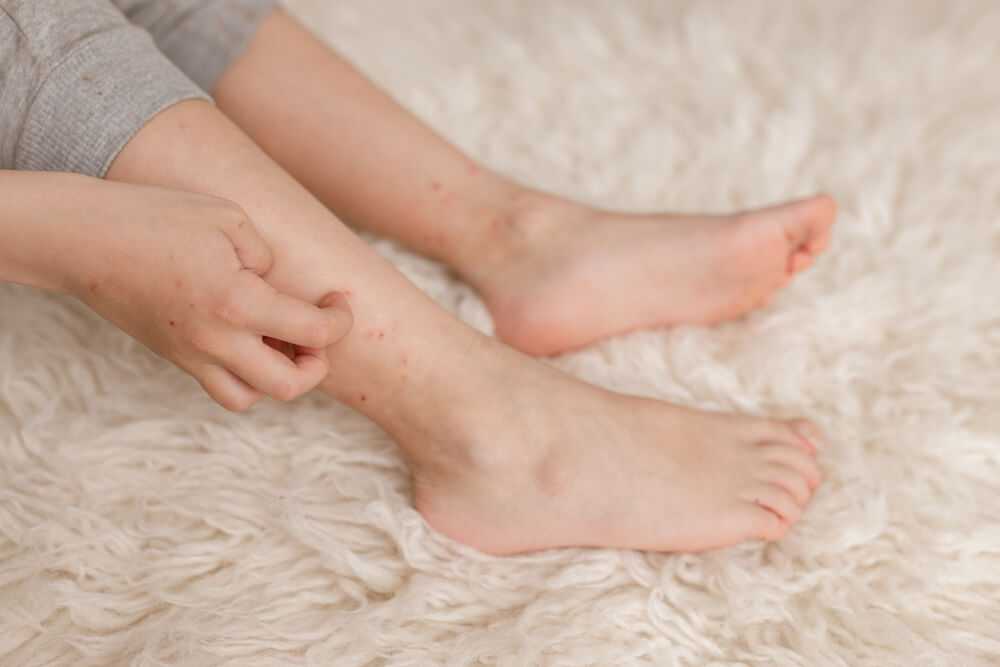Flea bites are small, itchy bumps that typically appear in clusters or lines, often on the ankles and legs. In this article, we will explore what do flea bites look like, how to identify flea bites, their symptoms, and treatment options.
Key Takeaways
- Flea bites appear as small, reddish bumps that cluster and can be intensely itchy, often causing significant discomfort.
- Prompt treatment and prevention methods, such as over-the-counter remedies and regular pet care, are crucial to managing flea bites and reducing the risk of infestations.
- Complications from flea bites, including secondary infections and the potential transmission of diseases, underscore the importance of timely identification and treatment.
Identifying Flea Bites

Flea bites have some distinguishing characteristics. Typically, they appear as small, reddish bumps with a central spot, often forming in straight lines or clusters. On lighter skin tones, flea bites are usually red, while on darker skin tones, they may blend with the skin color or appear darker. Despite their small size, flea bites can be intensely itchy and uncomfortable, causing significant irritation. Flea bites look like small, reddish bumps that can be quite bothersome.
Individuals with darker skin tones may find flea bites particularly challenging, as these bites often leave dark marks that may take months to fade. This hyperpigmentation can add to the frustration, making prompt identification and treatment crucial. Recognizing the appearance of flea bites is the first step in managing and preventing further issues.
Symptoms of Flea Bites
Symptoms of flea bites go beyond their physical appearance. The most common include intense itching, redness, and possible swelling. The itching is primarily due to the body’s reaction to flea saliva injected during the bite, triggering a histamine release, which also causes swelling. The flea bites itch is primarily due to this reaction.
For those who are allergic to flea bites, the symptoms can be more severe. An allergic reaction can lead to larger areas of redness, small pimple-like bumps, and heightened itching and swelling. Despite the discomfort, flea bites typically do not cause lasting harm and are more of an irritation than a serious health threat. However, the intense itching and potential for allergic reactions make it crucial to treat flea bites effectively.
Visual Guide to Flea Bites

A visual guide can be incredibly helpful in identifying flea bites. They appear as small, discolored bumps on the skin, and close-up images often show these bumps at various stages of healing. Initially, flea bites may be red or brown and can sometimes have a pale or discolored ring around them.
Hyperpigmentation from flea bites can lead to dark spots that may take months to fade, particularly for individuals with darker skin tones. These visual cues are essential for distinguishing flea bites from other insect bites and understanding their progression over time. Having a mental image of flea bites aids in quicker identification and timely treatment.
Common Locations of Flea Bites

Flea bites commonly occur in specific areas of the body, aiding their identification. Most affect exposed areas, particularly around the ankles and lower legs, as fleas prefer to jump onto these parts closer to the ground and more accessible.
The bites typically appear as small, itchy bumps that may cluster around these regions. Knowing these common locations is crucial for timely identification and response to flea infestations.
If you notice itchy bumps around your ankles and lower legs, it might be a sign of flea activity.
Differences Between Flea Bites and Other Insect Bites
Differentiating flea bites from other insect bites is key for appropriate treatment. Flea bites are generally smaller and often appear in lines or clusters, primarily affecting the ankles and legs. In contrast, mosquito bites are larger, solitary, and can occur on any exposed skin. Both flea and bed bug bites itch and can cause allergic reactions, but bed bug bites tend to be more evenly spaced and can appear in a linear pattern.
On lighter skin tones, flea bites often present a small red dot at the center, while on darker skin tones, they may blend with the surrounding skin or appear darker. If unsure whether a bite is from a flea or another insect, consult a healthcare provider for a proper diagnosis and treatment plan.
Causes of Flea Bites

Understanding why fleas bite humans helps in prevention and control. Fleas bite humans primarily to obtain blood meals necessary for their feeding and reproduction. They are attracted to humans when their typical hosts, such as pets, are not available. Fleas can feed on various warm-blooded animals, allowing them to switch hosts when necessary.
The flea’s bite involves piercing the skin and drawing blood through specialized mouthparts, followed by secreting saliva into the bloodstream. This process not only feeds the flea but also enables female fleas to reproduce rapidly, laying hundreds of eggs after consuming a blood meal, significantly contributing to flea infestations.
Treating Flea Bites
Treating flea bites effectively alleviates discomfort and prevents complications. Common over-the-counter treatments include calamine lotion, menthol creams, and oral antihistamines like Diphenhydramine (Benadryl). These can help reduce itching, redness, and swelling associated with flea bites.
Natural remedies such as oatmeal baths provide relief due to their anti-inflammatory properties, while diluted tea tree oil can help reduce discomfort and fight infections. Applying cold compresses or ice packs can effectively reduce swelling, soothe itchiness, and alleviate redness caused by flea bites.
These treatments help manage symptoms and ensure that flea bites heal properly.
Home Remedies for Flea Bite Relief
Several home remedies can provide relief from flea bites alongside over-the-counter treatments. Ice packs are a simple yet effective method to reduce swelling and numb the itch. Applying an ice pack for a few minutes can offer immediate relief and prevent further irritation.
Aloe vera gel is another popular home remedy known for its soothing properties on skin irritations. Applying it to flea bites can help alleviate irritation and promote healing.
These home remedies are easy to use and can significantly relieve discomfort caused by flea bites.
Preventing Flea Bites

Preventing flea bites involves a combination of pet care, household hygiene, and outdoor control measures. Using flea treatment for pets ensures they remain flea-free and do not carry fleas into the home. Protecting pets from wild or stray animals is also crucial, as these can introduce fleas into your environment.
Regular washing of bedding in hot water kills any fleas that might be present. Vacuuming frequently and immediately disposing of the contents can help control flea populations indoors. Additionally, steam cleaning carpets can kill fleas, though multiple treatments may be necessary due to hatching eggs.
Outdoor flea control includes mowing the lawn, removing yard waste, and planting flea-repellent plants like lavender and mint. Maintaining both pet hygiene and household cleanliness, alongside outdoor control efforts, significantly reduces the risk of flea bites.
Complications from Flea Bites
While flea bites are usually just a nuisance, they can lead to complications if not properly managed. Scratching flea bites can cause secondary infections, which may manifest as swelling, redness, and pus. Although rare, severe allergic reactions to flea bites can possibly lead to anaphylaxis.
Fleas can also transmit serious diseases, including the plague and flea-borne typhus, posing a public health threat. These potential complications highlight the importance of promptly treating flea bites and taking preventive measures to avoid flea infestation.
How to Get Rid of Fleas
Getting rid of fleas requires a comprehensive approach addressing both the home and pets. Regularly using a flea comb can help physically remove fleas from pets. Treating both home and pets simultaneously is essential to effectively eliminate fleas.
Carpets, rugs, and bedding should be thoroughly washed and vacuumed to eliminate adult fleas from the home. Effectively addressing every stage of their life cycle, from eggs to adults, is crucial. This comprehensive approach ensures fleas are eradicated and prevents future infestations.
Summary
Understanding and managing flea bites involves identifying the bites, recognizing their symptoms, and knowing how to treat and prevent them. Prompt treatment and preventive measures are crucial in avoiding complications and ensuring that flea bites heal properly. By following the advice in this guide, you can protect yourself and your pets from the discomfort and potential health risks associated with flea bites.
Flea bites can be identified as small, reddish bumps with a central dot, often grouped in lines or clusters on your skin. Prompt recognition is crucial to address the infestation effectively.
Flea bites typically cause itching, redness, and swelling, with allergic reactions potentially resulting in larger red patches and small pimple-like bumps. It’s important to address these symptoms promptly to prevent further irritation.
For effective relief from flea bites at home, use over-the-counter treatments like calamine lotion and oral antihistamines, along with home remedies such as ice packs and aloe vera gel. These methods will help soothe itching and reduce inflammation.
Flea bites commonly occur on exposed areas like the feet, ankles, and lower legs. It’s important to protect these areas to avoid discomfort.
Flea bites can lead to secondary infections from scratching and, though rare, severe allergic reactions or diseases such as plague and typhus. It’s important to monitor any bite symptoms closely to prevent complications.
"*" indicates required fields
"*" indicates required fields

